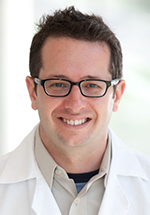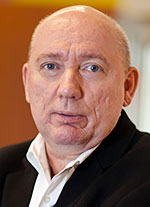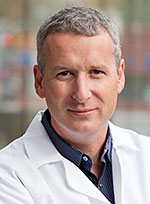

Genetics & Autism
Translating the Genetic Language of Autism into Treatment
Translational research aims to accelerate the pace at which basic research yields effective clinical treatments for human diseases by taking discoveries between "bench" and "bedside." For instance, translational researchers have identified alterations in a growing number of genes linked to autism spectrum disorder (ASD), with the goal of enabling earlier diagnosis — when intervention can do the most good — and improved treatment.

Brett Abrahams, Ph.D. At the forefront of this effort is Dr. Brett Abrahams, assistant professor of genetics. His research correlates genetic variations that elevate autism risk with changes in brain structure and function.
ASD is a catchall term that describes an array of cognitive and behavioral disorders characterized by three symptoms: impaired social interaction, difficulty communicating, and restricted interests and repetitive behavior. An added complexity: The degree of impairment with each aspect (or "phenotype") differentiates children with ASD from one another – even when they have the same genetic anomaly.
"Parents of children with autism know there isn't just one form of autism, and that each child is different," said Dr. Abrahams. "We know that a huge number of genetic variants, both common and rare, are important. It also seems likely that environmental factors interact with these genetic risk factors to modulate risk and severity of symptoms," he added. As he and other researchers elucidate the genetic and environmental mechanisms associated with individual autism phenotypes, Dr. Abrahams foresees that information about a patient's own genome may in some cases be used to develop a personalized treatment program to improve cognitive and behavioral function.
Making Sense of Order
"Einstein is famous for its collaborative atmosphere, and Dr. Abrahams' work is an example," said Dr. Jan Vijg, who chairs the department of genetics and holds the Lola and Saul Kramer Chair in Molecular Genetics.

Jan Vijg, Ph.D.Dr. Abrahams recruits families affected by ASD to provide DNA samples to study how the genetic makeup of those with ASD differs from those who are neurotypical. He also has access to DNA samples collected by Einstein's Children's Evaluation and Rehabilitation Center (CERC), which diagnoses and evaluates children and adolescents with autism and other developmental disorders.
"You need a well-equipped genetics department to identify gene variants that are useful for early diagnosis, and, possibly, as targets for new drugs," noted Dr. Vijg. Many disease-causing mutations occur in the exome, the protein-coding regions of genes, and sequencing these can efficiently zero in on gene variants associated with specific diseases.
Dr. Vijg explained that the "state-of-the-art" high-throughput sequencers at Dr. Abrahams' disposal can quickly determine the order of the four DNA bases — adenine, guanine, cytosine, and thymine — among the gene variants of large groups of children with and without ASD, after which "our computational geneticists and statisticians can compare the two groups to identify specific variants, such as a missing or repeated base that may play a role in autism."
Whenever a genetic variant of interest is identified, Dr. Abrahams will work with behavioral geneticist Dr. Herb Lachman to grow neurons from skin cells or baby teeth of patients with that variant in order to study how it affects neuronal growth and function
Most recently, Dr. Abrahams has been studying genetic variants in a section of Chromosome 15, known as 15q11.2, which is associated with the development of autism, epilepsy, intellectual disability, and schizophrenia. These variants, which involve deletions or duplications of DNA sequences in four genes at that location, can increase the severity of ASD symptoms.
"Access to these resources makes it possible for me to carry out work that I couldn't otherwise pursue on my own," said Dr. Abrahams. His work has identified new genes that can raise risk of autism and has helped improve genetic tests that screen for autism.
The Real-World Test

John Foxe, Ph.D.CERC phenotypes children diagnosed with ASD using a battery of tests to assess intellectual ability, expressive and receptive language skills and difficulties with sensory processing; neuroimaging techniques that measure blood flow and structural aspects of the brain; and neuroelectrophysiological recordings of the electrical activity in the brain as neurons communicate. After Dr. Abrahams genotypes these children, he and CERC researchers collaborate to look for "linkages between specific genetic variants, corresponding changes in brain structure and function, and severity of autism symptoms," explained neuroscientist Dr. John Foxe, who is CERC's research director.
Separate work, with Drs. Foxe and Sophie Molholm, is using neuroimaging and neuroelectrophysiology to see how genetic variants of interest impact brain structure and function in patients and in control group participants in the study.
"Working with Dr. Abrahams, we are trying to understand what is different about the brain of an autistic child and what mutations occurred in the genome that gave rise to these changes in brain structure and function," he added.
"The complexity of autism demands the kind of interdisciplinary work that Einstein permits, and I couldn't have dreamed of a better place to be doing the research I'm carrying out," said Dr. Abrahams.
Posted on: Tuesday, January 8, 2013

Tablet Blog